Menu
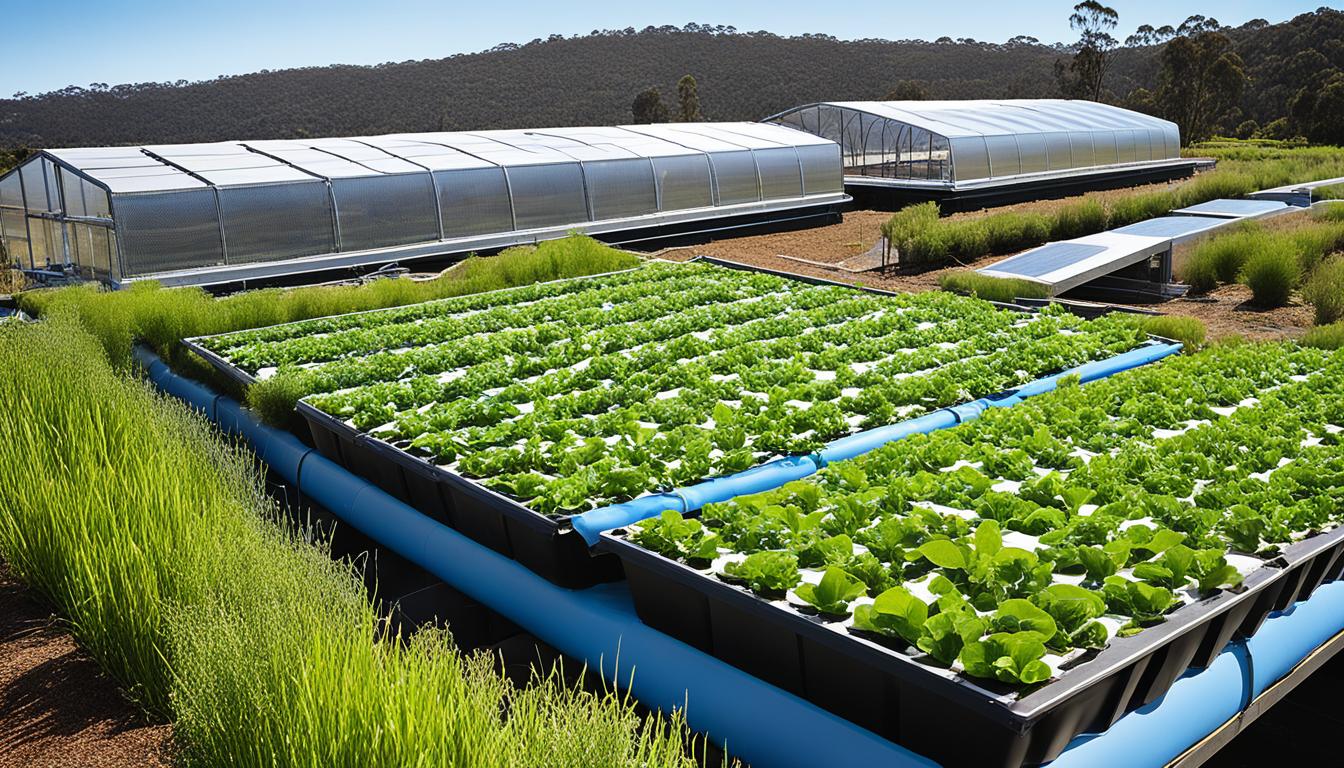
Did you know that aquaponics systems are much better with water than traditional farming? They can use up to 10 times less water. Love et al. (2015b) and McMurtry et al. (1997) say this makes them a great choice for Australia, which often faces water shortages.
Aquaponics in Australia is getting a lot of attention as a green farming method. But, it hasn’t fully taken off commercially. It’s important to really get aquaponics right in Australia to succeed. This study looks at how Australia’s aquaponics are doing, what they face, and their future. It aims to share if these systems are a good economic and green choice.
Aquaponics combines aquaculture and hydroponics, creating a sustainable mix. Fish and plants grow together. Fish waste feeds the plants, and the plants clean the water for the fish. This way, less water is used, and there’s no need for harmful fertilisers. Now, let’s explore how it works and its history.
Aquaponics is a clever blend of fish farming and plant growing. Fish waste serves as food for the plants. The plants also purify the water, which goes back to the fish. It uses much less water than usual farming and limits the use of chemical fertilisers.
Systems vary, like those from Aquaponia Iberia in Spain, designed for different climates. This shows aquaponics is key for future food needs. Schools use aquaponics to teach hands-on science, technology, engineering, and maths (STEM) lessons.
Aquaponics is ancient yet modern. The Aztecs grew plants on lake islands centuries ago. Now, places like the University of the Virgin Islands lead in its study, affecting farming worldwide.
Modern farms, like Sweet Water Organics in Wisconsin and Baan Batr in Thailand, show aquaponics’s community and urban potential.
Aquaponics is spreading worldwide, from Australia’s rooftops to cities like Green Sky Growers. It’s becoming more popular. Yet, it faces challenges in high energy costs.
Governments see its value, offering support to improve it. Aquaponics helps save land and lowers food transport pollution, making the earth healthier.
In summary, aquaponics is changing how we grow food. With ongoing improvements, it promises a sustainable food future.
Australia started exploring aquaponics seriously in the 1990s, especially in small backyard settings. People began with small experiments, growing into larger, commercial projects over time. Today, the country is a hub for aquaponics innovations. Even though large operations are not common, many are interested in exploring different aquaponics models.
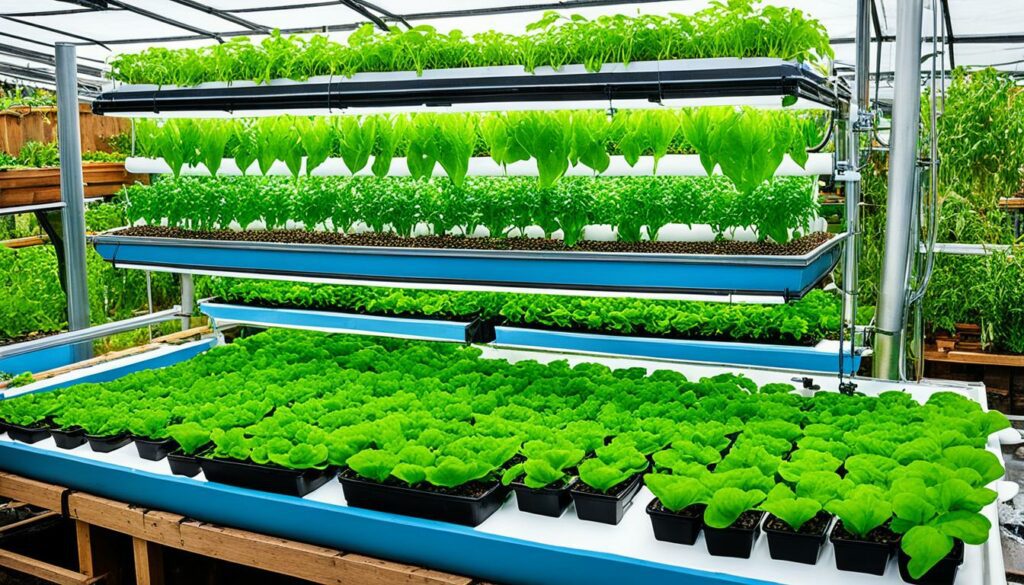
The journey began with simple setups in people’s gardens. Initially, these projects aimed for sustainable food production. As more people learned, the trend of backyard aquaponics grew.
In the early years, much focus was put on water and nutrient use. The goal was to make the systems as efficient as possible. Innovations like using salty groundwater in dry areas showed aquaponics’ potential to grow under challenging conditions.
Academics like Dr. Wilson Lennard had a big impact on how we understand aquaponics. They improved our knowledge, making aquaponics more practical for larger ventures.
Lennard’s studies highlighted the best ways to balance fish and plants in these systems. His work led to the adoption of new technologies, making aquaponics suitable for big scale farming. There’s also interest in using aquaponics in oceans for sustainable seafood.
A mix of industry and academic work has made aquaponics more popular. Many now trust its nutritional value and consider it safe and clean. These positive views reflect the growing interest in aquaponics.
The following table shows the public’s view and use of aquaponics in Australia:
| Aspect | Response Rate |
|---|---|
| Heard of Aquaponics | 63% |
| Deemed Safe and Clean | 87.5% |
| Agreed on High Nutritional Value | 75% |
| Considered Humane | 43.75% |
| Willing to Learn More | 50% |
Through a deeper study of aquaponics, both experts and enthusiasts are more optimistic. They see great potential for using aquaponics to change how we produce food. With ongoing support and new discoveries, the future of aquaponics in Australia looks bright.
Australia’s recent research has led to big steps forward in aquaponics. A survey found that 63% knew about aquaponics. This shows more people are learning about this sustainable way of farming. However, the survey also found that 87.5% had no hands-on experience with farming or aquaponics. This means we need to do more to teach people about it.
Australian experts, like Dr. Wilson Lennard, have made significant steps in aquaponics technology. Their work on saving water is especially important. Studies have shown aquaponics systems can use water up to 10 times more efficiently than traditional farming. This is a big win for the environment.
Research on what people think of aquaponics is also interesting. Most think it’s a safe and clean way to produce food. Many also believe the food grown this way is very nutritious. About half want to know more about aquaponics. This shows a big opportunity for aquaponics to grow.
But, not everyone is sold on aquaponics yet. A study found that in some places, people are more interested in eating aquaponic food. But in other areas like Berlin, most weren’t keen. This could be because of different cultural views. It highlights how important it is to talk to people about aquaponics in a way they understand.
Looking at aquaponics from an economic angle, some good news comes up. A study suggests that some shoppers might pay up to 40% more for aquaponic-grown food. But, results in the United States were different. There, people wouldn’t pay more for aquaponic lettuce.
Summing up, Australian research has shared insights into using water better, recycling nutrients, and what people think of aquaponics. This work is important for the future of aquaponics. While experts keep learning and coming up with new ideas, talking to people in ways they understand remains vital to the industry’s growth.
Australia’s aquaponics scene has grown thanks to key projects and efforts. Both the government and private businesses have pitched in, supported by schools and universities. These projects push aquaponics as a way to make food sustainably, improving communities, and educating people about it.
Government support is evident in partnerships with private businesses. For example, Green Sky Growers runs a sizable aquaponics farm on a roof. It shows how *aquaponics practices in Australia* can thrive, especially in cities.
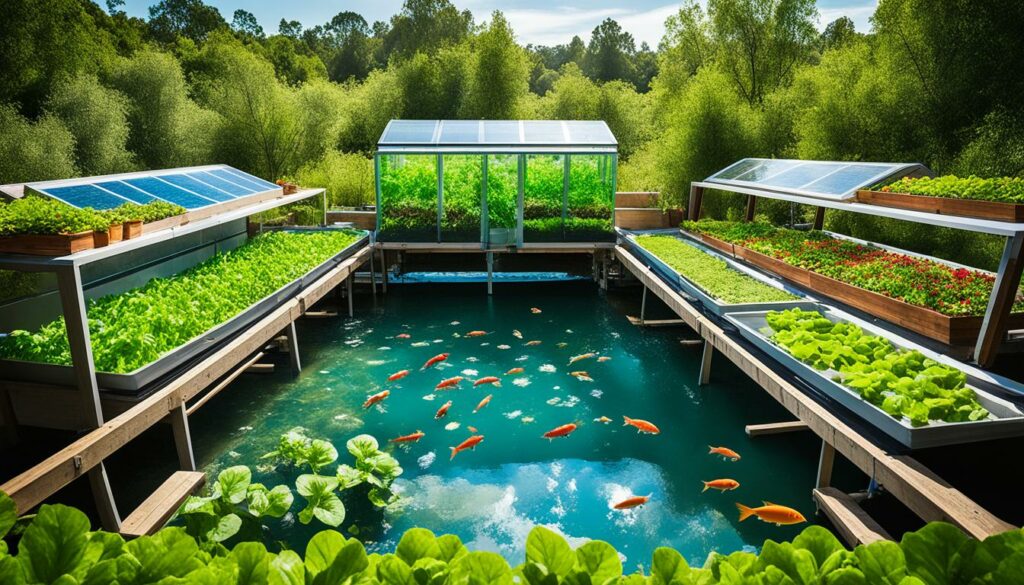
Overseas, places like Sweet Water Organics turned old factories into urban farms. They prove the worth of aquaponics technology review in growing cities sustainably. This lesson is top of mind in Australian cities aiming for a greener future.
In Australia, projects show off versatile *sustainable aquaponics practices*. They’re backed by initiatives from faraway places like the University of the Virgin Islands. Their work guides how Aussies teach and learn about aquaponics.
Around the world, places like Thailand’s Baan Batr boost local farming, helping folks look after themselves and share fresh food. This mirrors what Australia does to ensure everyone has enough to eat and knows about aquaponics.
The growing number of study articles, like the 666 on ScienceDirect, highlight aquaponics’ importance. Most of them look at fish and plant systems. This research is key for *aquaponics technology review* in Australia, be it in cities or the countryside.
| Project/Organisation | Region/Country | Key Contributions |
|---|---|---|
| Green Sky Growers | Australia | Commercial rooftop aquaponics, urban sustainability |
| Sweet Water Organics | Wisconsin, USA | Urban aquaponics, adaptive reuse |
| Baan Batr Social Enterprise | Thailand | Community self-sufficiency, fresh produce |
| The University of the Virgin Islands | USA (International Impact) | Pioneering research, global practices |
| Aquaponia Iberia | Spain | Customized systems, climate adaptation |
Aquaponics systems in Australia are known for their sustainability. They use innovative practices that are good for the environment and for saving money. This fits with Australia’s goals for the environment.
Aquaponics systems are amazing at saving water. They can be 2.37 to 10 times more water efficient than growing in soil (Love et al., 2015b; McMurtry et al., 1997). This is because the water is reused, cutting down the need for new water. So, these systems not only save water but also stay productive.
Aquaponics’ natural way of recycling nutrients is impressive. In these systems, bacteria change fish waste into plant food. This means there’s less need for chemical fertilisers. It’s similar to how nature works, which is great for the planet.
Due to the natural process of nutrient cycling, there’s less need for chemicals in aquaponics. Farmers only need to add a few essential minerals (Rakocy et al., 1997; Tyson et al., 2011). This not only saves money but also helps the planet by reducing pollution.
| Aspect | Aquaponics | Traditional Agriculture |
|---|---|---|
| Water Efficiency | 2.37 to 10 times more efficient (Love et al., 2015b; McMurtry et al., 1997) | Less efficient due to soil-based evaporation and runoff |
| Nutrient Use | Natural cycling reduces need for synthetic fertilisers | High reliance on synthetic fertilisers |
| Chemical Inputs | Minimal, with limited mineral additions (Rakocy et al., 1997; Tyson et al., 2011) | Higher use of pesticides and herbicides |
Sustainable aquaponics has many great features. It helps Australia protect the environment. Studies show it’s a smart way to do agriculture.
In Australia, there are aquaponics projects for both communities and commercial use. They use innovative ways to be more sustainable and advanced technologically. This includes the efficiency of water, which is between 2.37 and 10 times better than using soil for farming. This has helped to make more profit in many areas.
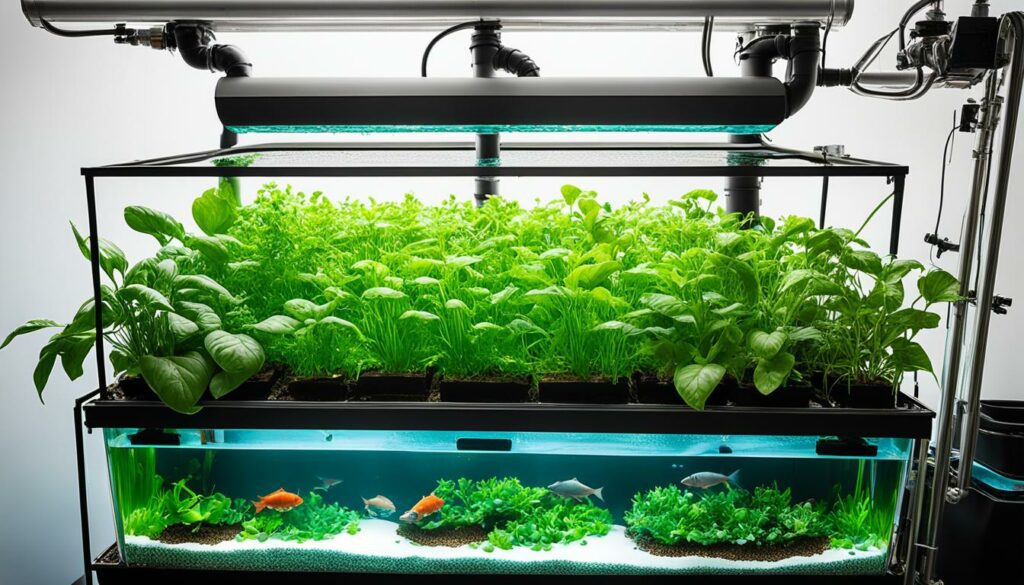
Australian aquaponics also show us how much people like it and its potential in the market. Studies in Melbourne found that 63% knew about aquaponics, and 87.5% felt it was safe for food. It matches a global trend where consumers pay more for products made this way.
However, making money with these systems is not the same everywhere. Some places do very well, while others just do okay. But getting certified organic helps people be willing to pay more, which could make profits go up by 5%. Recent studies also show that young, educated women tend to prefer eco-friendly products, helping the market.
“These aquaponics systems not only focus on sustainability but also resonate with the growing demand for organic and locally-sourced produce,” remarked one leading expert.
For a closer look, let’s compare aquaponics uses through a table:
| Aspect | Community Projects | Commercial Ventures |
|---|---|---|
| Scale | Small to medium | Medium to large |
| Water Efficiency | High (up to 10 times) | Moderate to high |
| Consumer Willingness to Pay | Elevated (up to 40% extra) | Elevated (13%-18% in regions) |
| Profitability | Variable | Variable |
In the end, studying aquaponics in Australia highlights its big potential. It combines new tech with the growing interest in sustainable, organic food. Whether used locally or for big business, aquaponics looks bright in Australia.
Aquaponics projects in Australia have shown great results. They highlight how aquaculture and hydroponics can work together. The study of aquaponic farming has deepened what we know. It covered the systems’ history and benefits. The Certificate of Aquaponic Production has made it easier for many to start their systems.
Australian aquaponics projects have achieved a lot. For example, they’ve grown top-quality fish like tilapia and veggies such as lettuce and kale. They’ve also helped the environment by using less water and fewer chemicals. Beyond those wins, these projects have been great for teaching and getting communities involved. People at home have found these systems save them work, water, and money.
But, not every story is a success. Some aquaponics projects have struggled with how people see them and getting into the market. Even though some folks are interested, only a small portion is really up for trying something new. And, just a few are ready to pay extra for aquaponic goods. However, through talks and interviews, experts are figuring out how to make aquaponics more popular and successful in farming.
The aquaponics system evaluation gives us great insights into the benefits and drawbacks of aquaponics in Australia. This analysis finds aquaponics use less water, up to 10 times more efficiently than growing in soil. The results vary based on the system’s design and the climate.
Global views on aquaponic food are positive. Places like Alberta, Canada, and Malaysia show big interest in buying such food. Many people there are ready to pay 40% more for it.
In the Scandinavian region, there’s a 13-18% more money to be made by selling “green” aquaponic products. Being certified organic is very important, potentially increasing profits by 5%.
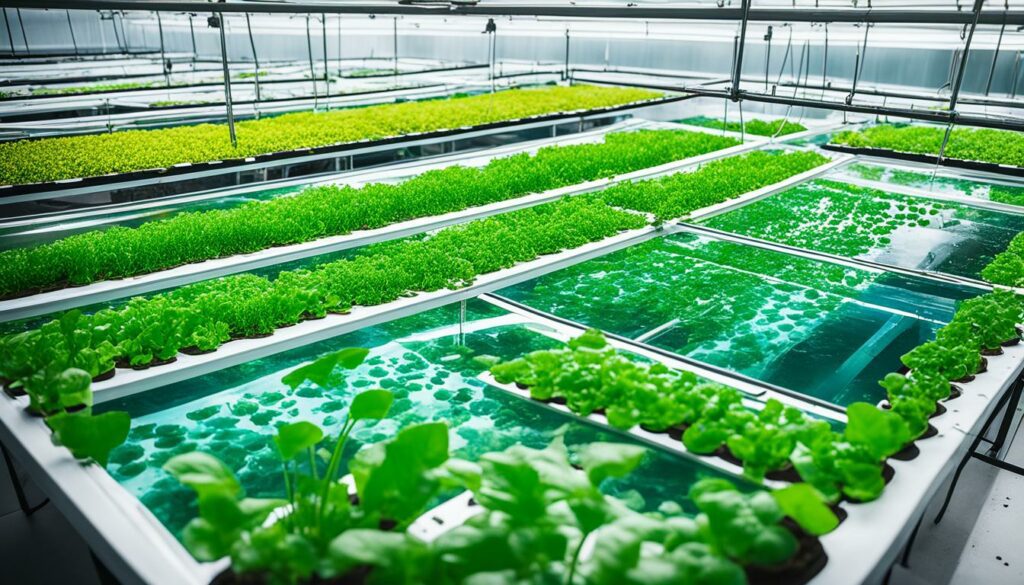
Studies also reveal that most, about 87.5%, think aquaponics is a safe way to farm fish and grow plants. And 75% say the food is nutritious. But, opinions on taste differ, suggesting an area for more study.
| Aspect | Findings |
|---|---|
| Water Efficiency | 2.37 to 10 times more efficient |
| Consumers’ Willingness to Pay More | Up to 40% |
| Scandinavian Premium | 13-18% |
| Impact of Organic Certification | Boosts willingness to pay by 5% |
| Perception of Safety | 87.5% find aquaponics safe and clean |
| High Nutritional Value | 75% agree |
It’s interesting that while many knew the term ‘aquaponics’, 50% wanted to know more. Over half said they’d buy this food at their next chance. But, some care more about the price than how it’s grown.
These results suggest we need to teach people more about aquaponic food and tweak how we sell it. Showing the good for the environment and our health could make it more popular. This could help aquaponics flourish and be good for the economy too.
Aquaponics is gaining attention for its ability to be sustainable and save resources. When figuring out if aquaponics is worth it financially, a cost-benefit analysis is key. It uses water much more efficiently than plant cultivation on soil, which is a huge plus. Still, how much profit you make can depend a lot on where you are and how big your system is.
Some commercial aquaponics farms are making money, but not all of them. Many need other ways to earn, like through tourists or teaching. Getting an organic certification could also help make more money, by around 5%. This is important in a competitive market.
Whether aquaponics succeeds often comes down to what people think of it. Surveys show that many people around the world are willing to pay extra for aquaponic food, up to 40% more. In places like Scandinavia, people are willing to pay an even higher premium. Yet, not everyone is sold because of different tastes and how much they know about aquaponics.
The way consumers view aquaponics matters, as some countries are very positive, such as Canada or the USA. But, in Berlin, Germany, there’s more doubt. This shows the need for specific marketing strategies.
To grow the aquaponics market, companies need to market well and engage with the public. They should talk about aquaponics’ health benefits and its safety, which most people agree are good. They should also share the benefits of buying aquaponic, as over half of consumers are interested. This shows people are ready to learn more.
| Factor | Result |
|---|---|
| Water Efficiency | 2.37-10 times more efficient |
| Willingness to Pay More | Up to 40% more |
| Premium in Scandinavia | 13-18% |
| Organic Certification ROI Boost | 5% |
| Consumer Purchase Inclination | 56.25% |
To fully unlock aquaponics’ market potential, it’s important to help consumers understand its benefits. This means using good communication and marketing. By working with local communities and focusing on the positives of aquaponics, we can increase demand. This supports the growth of aquaponics and its economic success.
In Australia, aquaponics systems are being looked at in many ways. People are studying how well they work, their finances, and if they help the environment. 63% of the people in a recent survey knew what aquaponics was. This shows a growing interest in this new way of growing food.
One big deal with aquaponics systems is their efficiency. They combine fish farming with growing plants without soil in a unique way. The survey found that 87.5% of the folks thought aquaponics was a great, clean way to grow food. This idea shows the strength and attractiveness of aquaponics for safe and clean food production.
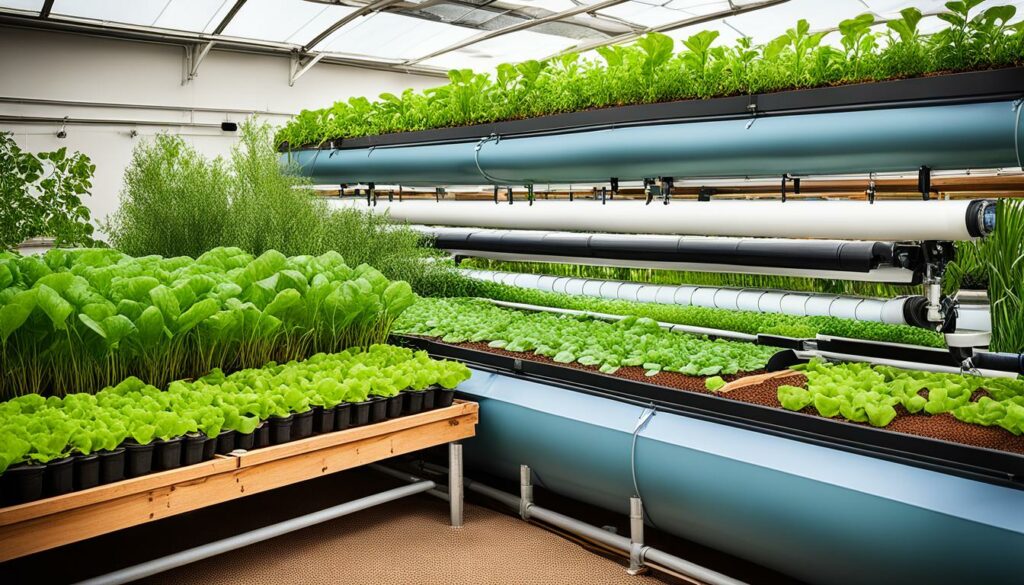
Looking at the money side, how well aquaponics systems do financially is key. Many people, 75% of those surveyed, know that the food from aquaponics is very nutritious. But, for some, the high prices are a worry. For almost half of the survey group, the cost was their top concern when choosing food.
However, a good number of people in the survey were ready to pay more for organic fish. This might make aquaponics projects more economically viable.
The way aquaponics affects the environment is also vital. Many see it as a kind way to farm fish, 43.75% in the survey said this. This shows people care about how their food is produced.
In terms of the market, half the survey participants were keen to learn more about aquaponics. This means educating the public is key to its growth.
On the other hand, there are still hurdles to jump over, mainly about the cost. Most say they wouldn’t pick organic food if it costs twice as much as regular food. This tells us that making aquaponics affordable is a big challenge.
In conclusion, we learn that aquaponics in Australia is at a complex intersection. It involves technology, finance, and eco-friendliness. Finding the right balance is crucial for its success. The insights from the survey offer a roadmap for future progress in this innovative sector.
Environmental impact assessments show aquaponics can greatly reduce the carbon footprint of farming. A study on a store’s aquaponic system in Sweden proved this. It was conducted on 11 January 2023 (DOI: 10.3389/frsus.2022.1051091). Compared to old methods, aquaponics produced fewer greenhouse gas emissions each year through the whole process of bringing goods to the store. The study identified electricity, CO2 enrichment, and heating as key environmental concerns.
Aquaponics significantly lowers the carbon footprint by using resources wisely. The study looked at producing 1 kg of various foods. It found that aquaponic systems emit far less greenhouse gases than bringing the same foods from other parts of Europe. This supports global efforts for sustainable agriculture.
Aquaponics is essential in ensuring steady food supplies, both in cities and the countryside. It can grow both veggies and fish in small, efficient spaces without using harmful chemicals. This makes it a great fit for both city life and dry areas. As of 2019, it showed great promise, helping to boost local food production and cut down on importing food.
To fully embrace aquaponics, we need fitting policies and regulations. Standard rules must change to support the special needs of aquaponics. Including aquaponics in environmental laws can encourage eco-friendly farming. Recent suggestions hint at using city waste for aquaponics, which would help the environment. Updating policies ensures aquaponics plays a significant part in sustainable farming.
The aquaponics industry is growing fast, and new technological innovations play a big role in this. In Australia, the latest aquaponics tech is changing the game. We’ll explore these new advancements and see how they could make a big difference.
One key area of change is system design. New aquaponics systems now have smart controls. They look after the water, its quality, and the food for the plants and fish. This means healthier plants and fish, leading to more food and a greener way of farming.
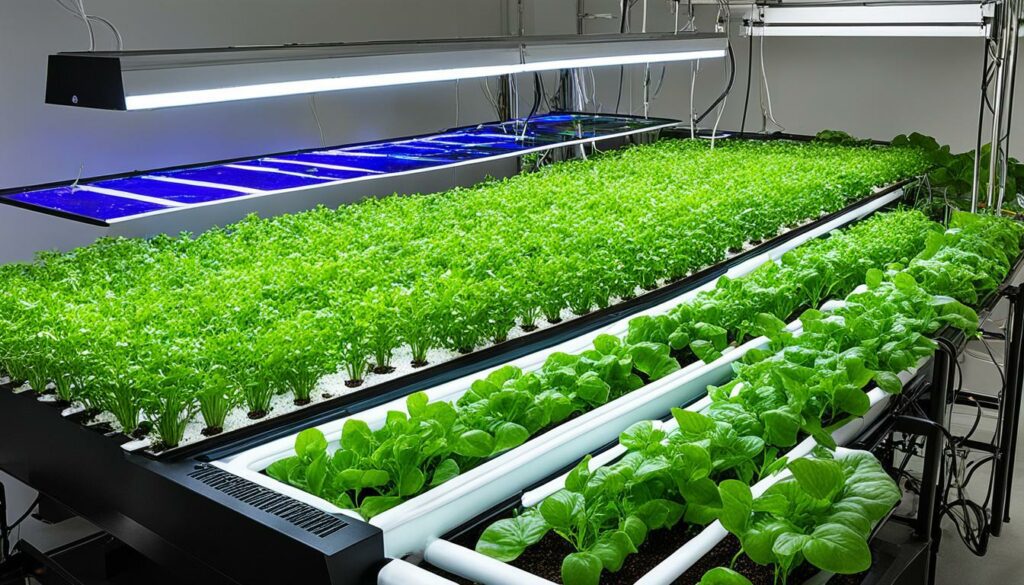
Nutrient management has also seen some major improvements. Plant food can now be given out in exactly the right amounts, boosting plant growth and fish well-being. Plus, better filters are cutting down on waste and keeping the water clean.
But the real standout is automation. This technology means real-time checks and fixes, without people having to do it all. It’s not just about making things easier, it’s also saving costs. This makes running aquaponics businesses on a bigger scale more doable.
Putting all these innovations into use is already showing some great results. A recent study found that most people think aquaponics food is nutritious and the farming method is clean. It’s a promising start.
But, there are challenges, too. Some worry about the fish and whether they’re treated well enough. And, prices are a concern for many, with some unsure if they’d pick organic food, even if it’s healthier. Still, many are curious about aquaponics. This shows there’s a growing interest and potential market.
A holistic aquaponics technology review shows a scene full of hope. New steps are taking on both the technical and public view challenges. Embracing all this new tech is the way to a brighter future, making aquaponics greener and more successful.
The future for aquaponics in Australia looks promising. New trends and technologies are ready to change the game. This will lead to the industry’s growth, tackling issues in farming with eco-friendly methods.
Research highlights some exciting new trends in aquaponics. Decoupled aquaponic systems aim to create the best environment for fish and plants. Another new method, marine aquaponics or maraponics, uses sea life to improve sustainability.
A big plus is the high water reuse in aquaponic systems, up to 99%. This means using salty groundwater in dry areas is now a real option.
Aquaponics in Australia has a lot of room to grow. Mixing aquaculture with hydroponics means better use of nutrients and less waste. It’s also a setup that piques the interest of half the people surveyed.
Most respondents know what aquaponics is and believe it’s a clean way to farm fish and grow plants together.
Still, aquaponics faces some challenges. Getting more people to buy organic food, even if it’s pricier, is tough. To turn this around, we need to teach consumers about aquaponics’ health and green benefits. Ongoing research is key to match nutrients for plants and fish. This needs to be paired with changes in the rules and getting the public involved more.
By tackling these issues, the aquaponics future in Australia can be bright. It moves us towards more sustainable, efficient, and profitable farming.
In ending our dive into aquaponics systems in Australia, their role in farming’s future stands out. They use as little as 1/10th the water traditional farming does, which is great for a place with water shortages. By using this method, Australia is making big steps towards farming that’s both efficient and eco-friendly.
People are willing to pay more for food grown with aquaponics, showing promise. In certain places, like Scandinavia, those who care for the environment pay a bit extra. This suggests a growing market for these products, although challenges still exist to make them profitable.
More and more people are learning about and approving aquaponics, saying it’s safe and clean. Yet, not everyone is sold on it, like in Berlin. To help aquaponics become a go-to in Australia, educating people and gaining support are key. This journey in Australia shows the promise and challenges of sustainable farming.
A case study dives into the use of aquaponics in Australia. It looks at what’s been done, what it’s achieved, and what we’ve learned. This includes how sustainable it is, its economic benefits, and any new tech.
Aquaponics is a mix of two things: growing plants without soil and fish farming. In this setup, the fish waste feeds the plants. In return, the plants clean the water for the fish.
Aquaponics is used worldwide in cities and the countryside. It helps produce food without harmful chemicals. This is good for the planet and meets food security goals.
Academics like Dr. Wilson Lennard have made big strides. They have improved aquaponics’ water use and how it cycles nutrients. Their work has shaped aquaponics in Australia a lot.
Studies in Australia have shown aquaponics can save a lot of water and reduce waste. They also found it can make farming more sustainable. But, they’re still checking if it’s a good money move.
Both governments and private businesses are getting behind aquaponics. This is to show it’s a real option for making food that’s good for the environment. They often educate and involve local communities too.
If you use aquaponics, you don’t need a lot of extra water. This is a big deal for places like Australia where water’s precious. It’s all about being smart with water.
Case studies show that using aquaponics at different levels works well. They review the processes, tech, and money side of things. This gives us a deep look into aquaponics in Australia.
There have been great stories like making top-notch fish and plants with less water. These tales show that aquaponics is good for the planet and can feed people in many places.
Getting people to like and buy aquaponics food has been tough, hurting its growth and making money. Tackling these hurdles with smart marketing and education is key to its success.
Looking at the numbers, it’s clear aquaponics saves water and cuts down on waste. It has the potential to make farming more green. But, it needs more people to understand why it’s important.
Some aquaponics projects have made a good profit, but not all. The key to its success lies in what people think and whether they’re willing to pay more for eco-friendly food.
Looking at its effect on the environment, aquaponics seems to do well. It cuts down on waste and works in both cities and the countryside, making food in a way that’s kind to our planet.
New tech is all about making aquaponics more efficient, from how the systems are designed, to how nutrients are managed, and automating tasks. These changes aim to make aquaponics better in producing food in eco-friendly ways.
In the future, aquaponics could get bigger and better thanks to new ideas and ways of doing things. But, there are still challenges to overcome. Educating the public and making laws that support aquaponics are crucial for its future success.